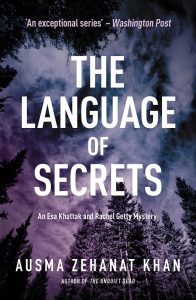On Writing: Ausma Zehanat Khan
 Crime fiction has no shortage of gutsy, brilliant and intriguingly flawed heroines, so when I set about writing my own mystery series, I knew I wanted one of my detectives to embody those same qualities. Esa Khattak and Rachel Getty are partners who work at Community Policing, a unit that investigates crimes that impact minority communities. Esa is the senior detective, in both age and experience, and though Rachel is a decade younger than her partner, I deliberately invested her with qualities that make her Esa’s equal in their partnership.
Crime fiction has no shortage of gutsy, brilliant and intriguingly flawed heroines, so when I set about writing my own mystery series, I knew I wanted one of my detectives to embody those same qualities. Esa Khattak and Rachel Getty are partners who work at Community Policing, a unit that investigates crimes that impact minority communities. Esa is the senior detective, in both age and experience, and though Rachel is a decade younger than her partner, I deliberately invested her with qualities that make her Esa’s equal in their partnership.
This was important to me for a number of reasons. Over the course of the series, I wanted the partnership to evolve with Esa and Rachel learning from each other, rather than using a paternal or hierarchical approach. Not that Esa doesn’t have things to teach Rachel. After all, as a Canadian Muslim of South Asian background, his lived experience gives him a unique and relevant perspective on their cases. But Rachel has things to teach Esa as well, things that his privileged upbringing and rapid rise through the police force have either shielded him from or closed his eyes to.
Rachel comes from a more challenging background. Her harsh and unforgiving family dynamics have shaped her view of the world and made her naturally resistant to authority, particularly male authority. Rachel’s father is police superintendent Don Getty – a man whose professional reputation may be legendary, but who is a bully and tyrant at home. Part of building Rachel’s psyche as a woman who feels the constant need to prove herself and hold her own in a room full of male colleagues, has much to do with her father’s domineering influence.
But in shaping Rachel, I didn’t want to focus only on her father. How Rachel relates to her mother – the victim of Don Getty’s abuse – was critical to developing Rachel’s perspective on police work. Her love for her missing younger brother Zachary was another essential element. Rachel can look at her mother’s experience and see all the things she doesn’t want her own life to be. She can think about her seven-year search for her brother, and though she grieves for the time she’s lost, discover that her suffering has made her resilient. Through the obstacles thrown in her path during her search for Zachary, Rachel has learned to stand up to anyone who might try to deter her from uncovering the truth – an essential quality as Rachel tries to move up the ranks of a still male-dominated profession.
Rachel, as a character, reflects the qualities of many of the women I know. She has the mental toughness to handle the sexism and condescension she often encounters on the job, yet at the same time, she offers gentleness and limitless compassion to the victims of the crimes she and Esa investigate. And her compassion extends further still, to the broken and lost who unwittingly stray across the path of a killer.
Putting Rachel in these highly emotive settings to interact with characters who challenge her as a woman and an investigator allows me to bring out the different sides of her character. And I try to do this without ignoring the reality of what it’s like for Rachel to do the job she does, just as many women move through a world where their expertise or experience is routinely challenged or dismissed.
In my novels, the crime is front and center, but I endeavour to make Rachel’s internal and external worlds as authentic and familiar as possible. To do that, I have to move beyond Rachel and examine her relationship with others. I have to think about the world I create for her to move through. Does it include other women? Is their background similar or dissimilar to hers? Does adding another woman to a scene that Rachel is in mean that the two women must be shown in conflict or competition, or that their conversation must focus on the men in their lives? Some scenes are like that because conflict is inherent and necessary to stories about serious crime. And some scenes involve Rachel discussing her romantic relationships or the relationships of others, particularly as the series progresses, just as happens in life.
But there is also more. There are times that Rachel mentors or protects younger women, as she does with Grace in The Language of Secrets. Or when Rachel feels antagonism towards other women, that later evolves into respect and liking. Sometimes Rachel dislikes someone personally while fully appreciating their importance to another character, as with Esa’s sister Ruksh.
One relationship has been particularly important for me to develop over the course of the series: the relationship between Rachel and Royal Canadian Mounted Police (RCMP) Superintendent Martine Killiam.
Killiam holds a senior rank in the RCMP and she’s been where Rachel has been, struggling to establish herself professionally while her ambitions for her career have often been held against her, simply because she’s a woman. Now highly ranked, Killiam keeps an eye out for promising women candidates in law enforcement. By mentoring women like Rachel, she demonstrates her solidarity. And for women who’ve experienced harassment in the police service as Rachel has in the past, Killiam’s solidarity represents a place of safety and understanding, reflective of the circles that women build for themselves in their personal and professional lives.
With every book, I think of how to deepen Rachel as a character, internally and through her experiences with others. I think of what she has to learn, as well as what she has to teach. She’s strong in the way that many of the women I know or have worked with are strong: multidimensional and endlessly capable without being infallible. Rachel’s flaws and her process of growth are what make writing her so rewarding. I find myself eager to dive in.
—
Ausma Zehanat Khan holds a Ph.D. in International Human Rights Law with a specialisation in military intervention and war crimes in the Balkans. She has practised immigration law and taught human rights law at Northwestern University and York University. Formerly, she served as Editor in Chief of Muslim Girl magazine, the first magazine to reflect the lives of young Muslim women.
Her debut novel, The Unquiet Dead, won the Barry Award, the Arthur Ellis Award and the Romantic Times Reviewers Choice Award for Best First Novel. She is a longtime community activist and writer. Born in Britain, Ausma lived in Canada for many years before recently becoming an American citizen. She lives in Colorado with her husband.
Ausma Zehanat Khan, author of The Language of Secrets, The Unquiet Dead and The Bloodprint
July 21, 2018
Find out more about Ausma on her website http://www.ausmazehanatkhan.com/
About THE LANGUAGE OF SECRETS
 The Unquiet Dead author Ausma Zehanat Khan once again dazzles in The Language of Secrets, a brilliant mystery woven into a profound and intimate story of humanity.
The Unquiet Dead author Ausma Zehanat Khan once again dazzles in The Language of Secrets, a brilliant mystery woven into a profound and intimate story of humanity.
Detective Esa Khattak heads up Canada’s Community Policing Section, which handles minority-sensitive cases across all levels of law enforcement. Khattak is still under scrutiny for his last case, so he’s surprised when INSET, Canada’s national security team, calls him in on another politically sensitive issue. For months, INSET has been investigating a local terrorist cell which is planning an attack on New Year’s Day. INSET had an informant, Mohsin Dar, undercover inside the cell. But now, just weeks before the attack, Mohsin has been murdered at the group’s training camp deep in the woods.
INSET wants Khattak to give the appearance of investigating Mohsin’s death, and then to bury the lead. They can’t risk exposing their operation, or Mohsin’s role in it. But Khattak used to know Mohsin, and he knows he can’t just let this murder slide. So Khattak sends his partner, Detective Rachel Getty, undercover into the unsuspecting mosque which houses the terrorist cell. As Rachel tentatively reaches out into the unfamiliar world of Islam, and begins developing relationships with the people of the mosque and the terrorist cell within it, the potential reasons for Mohsin’s murder only seem to multiply, from the political and ideological to the intensely personal.
Category: Contemporary Women Writers, On Writing






























